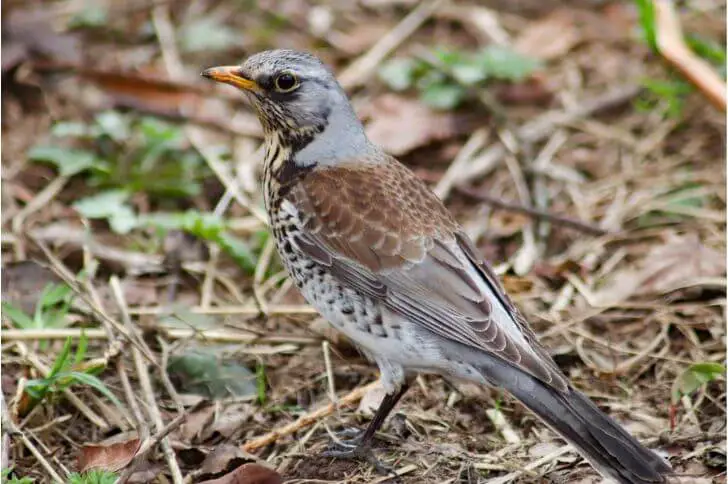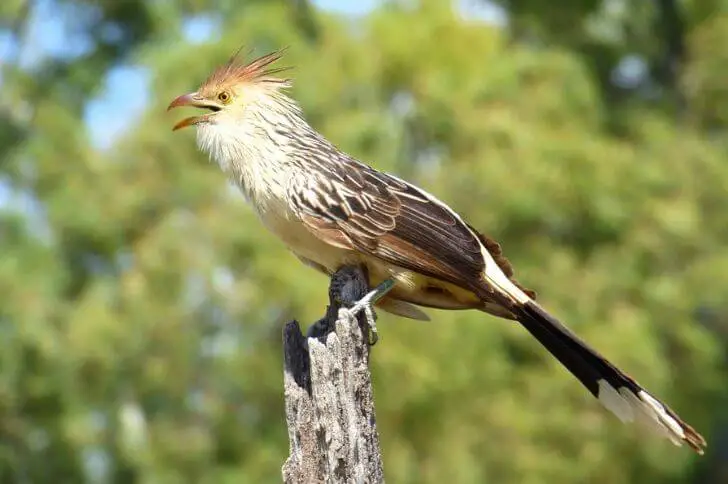Brown birds with orange beaks are a sight to behold! From the flight patterns, to the unique color and shape of their beaks, these birds have attracted the attention of birdwatchers and casual observers alike.
With a variety of different species exhibiting this intriguing color combination, there is a wealth of information to explore regarding the biology and behavior of brown birds with orange beaks.
Below we’ll look at 5 common birds with brown bodies and orange beaks. From the Virginia rail to the collorared puffin, all are fascinating to observe and study.
List of Brown Birds with Orange Beaks
1. Virginia Rail

Preferring brackish marshes and freshwater areas, the virginia rail is a cousin of the king rail. Sexes are similar with medium size, chicken-like bodies that range from 7.9-10.6 inches long.Their Wings span 12.6-15.0 inches.
Virginia rails are brown with a noticeable gray face. The long thick bill is orange-red. Legs are also orangish but look brownish due to mud. Also take note of the white and black striped rump that’ll help you tell them apart from other marsh birds.
Habitat & more:
Where can you find Virginia rails? In winter they move to the southern US and Central America. During summer, these birds return to the north to breed. Also, some birds have made the Pacific Coast their permanent home and can be found all year round.
Their preferred habitats are marshes and it’s often hard to see them through the dense rushes and cattails. What do these brown birds with orange beaks eat? They mainly consume snails and slugs, spiders, frogs and small fish. This food is also fed to their young.
Speaking of rail babies, during nesting season these birds construct nests on floating vegetation. They are excellent breeders, raising up to two clutches of 4-13 babies. These birds with brown feathers and orange beaks practice monogamy each season and prefer solitary life during their non-breeding season.
2. African Finfoot

source: wavethree
The African Finfoot has a variety of features that make its identification quite easy. Sexes are almost similar but there are some features that’ll help you tell them apart.
Male finfoots sport a brown back with white spots and underneath they are white. Their webbed feet and bill are neon orange; very noticeable. Also their heads are black with a noticeable white stripe that extends from the back of the eye to the neck.
Females have similar body shape, duck-like, and color. Their feet are also bright orange.
To tell sexes apart, look at their throats. Male African finfoots have gray throats while females are white. Also females have dark colored bills while males are bright orange.
Habitat & more:
The African Finfoot can be found in wetlands, rivers and estuaries throughout Africa’s sub-Saharan region.
Like the marsh bird above, this brown bird with orange beak consumes crustaceans, snails, amphibians and fish. They can pick food off the surface of water and also forage on land, along river banks.
These birds prefer staying in pairs. They are very secretive so if you get a chance to see a pair, make sure to get some photos.
3. Black-throated Saltator

Closely related to tanagers, black-throated saltators are an often overlooked type of songbird found throughout South America.
Because of their dull color, they are easy to miss in dense foliage. Black-throated saltator’s sexes are similar. These birds are brown overall with a darker back and long dark tail. Their orange canonical bill contrasts the black face.
Habitat & more:
They are typically found in forest edges and open savannas. Black-thoated saltators eat fruits and seeds that can be found in their environment. On occasion, these birds with brown bodies and orange beaks will also consume nectar.
Also, these brown birds with orange beaks can be heard giving out loud whistles during flight or while perched in trees; they sing most heavily during the breeding season.
Related Read: Check brown birds with yellow beaks
4. Collared Puffbird

Easy to spot due to their bright plumage, the collared puffbird is one of the cutest, small brown bird with orange beak.
The adult is about 7.5 inches in length; two inches larger than a chickadee but smaller than a robin. Adults are plump with a brown crown, and brown barred wings and tails. Underparts are whitish with a large black band on their nape. Note the orange eyering and bill.
Habitat & more:
They are native to the Amazon Basin. Its main prey include snakes, lizards, large insects and frogs.
You can watch their breeding habits from May through September. They raise only one or two babies each season.
Collared puffbirds have distinctive vocalizations that help them communicate with each other in dense forest environments. These include “awwAWW-chaw” which are only produced at dawn. They sing in pairs.
5. Double-banded Sandgrouse

The double-banded sandgrouse is a species of bird native to the deserts of central, eastern and western Africa.
This medium-sized bird has a wingspan of 12 inches and a body length of 9.8 inches. From far, sexes look similar but up close you can tell them apart. The male sandgrouse has a uniformly brown body with large white spots.
His neck is plain brown-grayish. Also the male has a distinctive white forehead with a thick black band that runs across the face and another black band across its chest which females do not have.
Both sexes have orange beaks and eyerings.
Habitat & more:
This sandgrouse is common in Malawi, South Africa, Zimbabwe and Angola. These medium size brown birds with orange beaks favor grasslands and areas with scanty vegetation.
Breeding takes place from February to September. Nesting spots are in between grass tufts where eggs and nestlings can be hidden from predators. Chicks leave the nest after 30 days.
6. Fieldfare (Turdus pilaris)

Fieldfares are migratory birds in the turdus genus. They are related to American robins. These brown birds are unmistakable with roundish bodies that measure about 9.8 inches and span 5.7 inches.
Both sexes have dark brown backs, slate-gray heads and rumps. On the underside, these medium size birds have spotted chests and flanks. Its belly is covered by pure white feathers. Their bill is yellow-orange.
Habitat & more:
Where can you find fieldfares? They breed in the north, Sweden, Belgium, Norway, and Austria. They winter in southern Europe and parts of Africa.
Like other birds in their genus, fieldfares are omnivorous. They eat earthworms, slugs and snails, and beetles. During winter they’ll eat berries from junipers, yews, holly, and hawthorns.
Fieldfares are aggressive when nesting. Their season starts in May, but sometimes in July depending on region, with the female constructing the nest solo. Nest is constructed using weeds, grass and lined with mud.
7. Guira Cuckoo

The guira cuckoo is the only member of the genus guira. It has a long slender body, measuring about 13 inches with a body mass of 4.9 oz. Male and female species have similar coloring.
They are dark brown above with an orange-brown shaggy crest. On the underside, this cuckoo has a whitish throat and buff underparts. Notice the long, broad tail with white tips.
Habitat & more:
This slender bird prefers open habitats; wetlands and pastures. It is common to eastern South America. Guira cuckoos stay in flocks of 15-18 birds. They are feeders, preying on small animals that cross their path.
These cuckoos eat mice, lizards, frogs, other birds’ nestlings and insects.
8. Clapper Rail

Native to the Atlantic Coasts and parts of the Caribbean Islands, the clapper rail is a chicken-like bird. It is about 13-16 inches in length with a brownish body and reddish-brown chest. The long slightly curved bill is orange-grayish.
Another way to identify this rail is by looking at its tail. Clapper rails have short tails and long strong legs.
Habitat & more:
Where can you find these brown birds with long beaks? If you live in the East Coast, check around salt marshes; in areas with lots of mangrove and pickleweed.
Like the cuckoos above, these rails are opportunistic predators. They eat fish, crabs, plant matter, and crustaceans
FAQs
What kind of bird is brown with an orange beak?
Virginia rails. These chicken-like birds are brownish overall with a long and slightly curved orange beak. Sexes have similar plumage.
What wild bird has an orange beak?
Common birds with orange beaks include Virginia rails, African finfoots, Collared puffbirds, and guira cuckoos.
Sources:
https://en.wikipedia.org/wiki/Fieldfare
https://www.audubon.org/field-guide/bird/virginia-rail
https://en.wikipedia.org/wiki/Guira_cuckoo
Hi fellow bird watcher. Welcome to our small corner of the world. At the spanishbirdguides.com our mission is to share with other bird watchers the things we love about birds, where to go bird watching within the United States, and more. I’d also love to hear from you. Feel free to contact me about your bird watching escapades, share videos, photos and more.


